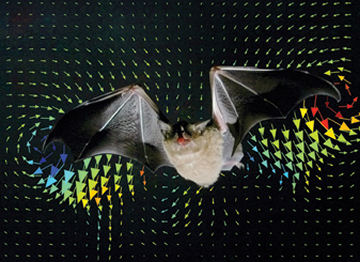Experiments that reveal the swirling air around a flying bat indicate that those mammals generate lift and thrust with their wings much differently than birds do.

At first glance, birds and bats seem to move through the air in similar fashion. However, aerodynamic details of the two groups’ flapping techniques, particularly at low flying speeds, are quite different, says Anders Hedenström, a biomechanicist at Lund University in Sweden. On the upstroke, a bird can separate the large feathers on its wings, permitting air to flow cleanly through and minimizing any downward, altitude-robbing force. Bats can’t do that, he notes, because their wings are continuous, although flexible, membranes.
Hedenström and his colleagues studied the flight techniques of Glossophaga soricina, a 5-centimeter-long, nectar-feeding bat that ranges from Mexico to northern Argentina. The team used a wind tunnel similar to the tunnels employed by engineers to evaluate scale models of aircraft. During the experiments, the bats drank a sweet solution from a tube dangling in front of cameras as they hovered facing a headwind.
Laser pulses illuminated tiny liquid droplets delivered into the airflow and enabled the researchers to calculate the strength and rotation of the eddies that the bats’ flapping wings created, says Hedenström. The researchers describe their findings in the May 11 Science.
When flying at slow speeds, about 1.5 meters per second, the bats turned their wingtips upside down and quickly flicked them backward during an upstroke. Scientists had surmised that this trick, previously seen in high-speed movies, provides lift and thrust, says Hedenström. By revealing vortices that signify lift, the new experiments bear out that theory, he notes.
At higher speeds, the backward flick during the upstroke disappears, and the configuration of vortices downstream of the bat indicates a more complex airflow over the wings. During some parts of a wing beat, the data suggest, airflow across the inner portions of the wing causes a force that pushes down on the membrane there. Nevertheless, says Hedenström, the strength of the vortices indicates that the bat’s wings, as a whole, generate more lift than aerodynamic models suggest.
The team’s laser-illuminated experiments “provide a beautiful look” at the aerodynamic wake behind a flying bat, says Douglas R. Warrick, a biologist at Oregon State University in Corvallis. “It’s the only way to actually know what’s going on with the airflow over a flapping wing, and even then it’s difficult,” he notes.
It’s clear that these bats are employing unknown tricks of aerodynamics to generate lift, says Sharon Swartz, an evolutionary biologist at Brown University in Providence, R.I. She and her colleagues recently reported similar findings from wind tunnel experiments on a larger species of bat.







